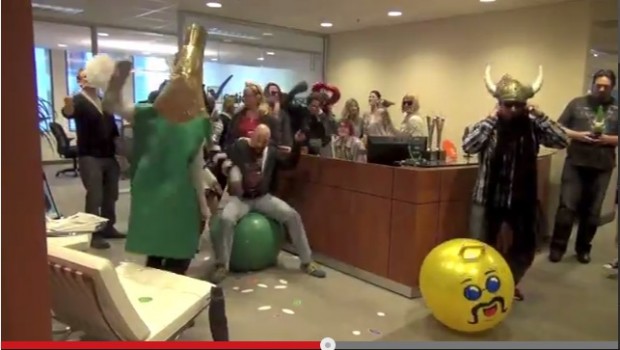
The 3 Best Viral Video Campaigns of 2013
 Happy New Year! 2014 has begun, but before we dive into a new year, let’s take a look back at the best viral video campaigns of 2013. How can these videos help with your 2014 marketing efforts? Excellent question! The answer is simple. While you don’t have to create viral videos yourself, they’re still excellent pieces of content you can learn from and leverage for your own business. Riding the popularity wave (when and if appropriate) also proves you’re still tuned into the zeitgeist. So let’s take a look at the best viral videos from 2013 and what we can learn from them:
Happy New Year! 2014 has begun, but before we dive into a new year, let’s take a look back at the best viral video campaigns of 2013. How can these videos help with your 2014 marketing efforts? Excellent question! The answer is simple. While you don’t have to create viral videos yourself, they’re still excellent pieces of content you can learn from and leverage for your own business. Riding the popularity wave (when and if appropriate) also proves you’re still tuned into the zeitgeist. So let’s take a look at the best viral videos from 2013 and what we can learn from them:
The Harlem Shake:
In 2012, a song called “Harlem Shake” was released by music producer Baauer. In February of 2013, videos set to the song “Harlem Shake,” began emerging. Each video included “a masked individual dancing alone in a group before suddenly cutting to a wild dance party featuring the entire group,” (knowyourmeme.com). According to YouTube’s official trend report, in the second week of February 2013, over 4,000 “Harlem Shake” videos were uploaded to YouTube each day! The videos had a simple setup, yet each one was different and brief, appealing to modern Internet users’ attention spans. A multitude of people (Jimmy Fallon), groups (the Norwegian Army), companies (Google, Facebook), schools etc. joined in on the Harlem Shake video craze. They were performed anywhere from underwater to airplanes, and even space. The videos served as a quick and funny way to contribute to the virality, all while subtly promoting particular companies, sports teams (The Miami Heat have one) or products. We even did one at VerticalResponse, too.
Dove Real Beauty Sketches:
The award for most popular video of 2013 goes to: Dove Real Beauty Sketches. This video has over 61 million views to date on YouTube and even more on hosted sites around the web. According to audience measurement service Visible Measures, the Dove Real Beauty Sketch was the most watched Internet video of 2013. The brilliance of this simple campaign is that it has nothing to do with Dove’s products, but instead focuses on changing the way we see ourselves and by association the way we view Dove as a company. The campaign sets out to prove that we see ourselves differently than others see us, pointing out that we are in fact overly-critical of ourselves – a revelation that makes most of us feel better about our own appearance.
While the Dove Real Beauty video isn’t necessarily a video you can mimic for your product or company, its success proves a valuable lesson. Marketing your company isn’t always about focusing on your products or services directly. Instead, potential users and customers are more likely to look at and be enticed by campaigns that reference your industry and your culture. Consumers are constantly bombarded with ads to buy various products, hence an original video that doesn’t appear to be selling anything other than a concept or message, becomes riveting. Dove succeeds in showing that their company culture isn’t about making you beautiful, but rather, bringing beauty that’s already there to the forefront.
Prankverts:
In 2013, a relatively new style of viral video sprung onto the Internet: “Prankverts” or “Prankvertising.” These videos involve advertising your product by using hidden-cameras and pranking unsuspecting bystanders. It’s a modern version of the 1983 “Folgers Coffee Commercials,” but rather than mildly pranking restaurant goers by changing out their coffee, these Prankverts aimed to shock unwitting participants and entertain online ones. Prankverts appeal to a wide audience and can be used in almost any setting and for any product. Take a look at this one from Mundo LG titled, “Ultra Reality: LG Meteor Prank.”
One of the most popular examples comes from Pepsi MAX and their “Jeff Gordon Test Drive” video. In the video, professional stock car racing driver, Jeff Gordon (in disguise) takes an unsuspecting car salesman on the scariest ride of his life and records the ‘experience’ via a hidden camera inside a Pepsi Can. The video, which received over 40 million views, appeals to everyone who has ever wanted to test drive a sports car and just let ‘er rip. While this isn’t about getting us to purchase Pepsi, the company knows the success of the viral video will bring users to their online websites and pages.
My personal favorite Prakvert of the last year was the viral marketing video created for the October 2013 release of the film, Carrie. The video, titled “Telekinetic Coffee Shop Surprise” set up a prank in a coffee shop with several actors and lots of stunts to scare customers into thinking that something supernatural was occurring in the middle of their ordinary day. The video ends with the smallest amount of footage from the upcoming film, the title and the release date. Rather than simply trying to hook viewers with a standard film trailer, the marketers took Carrie out of the world of fiction and placed her in an actual coffee shop. Though we know it’s not real, the reactions of the customers are real.
The lesson to take away from these creative ads is the appeal and success of using the suspense, surprise or shock factor. Though we don’t necessarily condone you to prank or scare away potential customers, you can test the surprise factor in your email subject lines, blog posts and social marketing campaigns. The company/website Upworthy does an excellent job of hooking readers in with their suspenseful headlines, particularly on Facebook.
Learning from and leveraging viral videos is a fun and creative way to move the focus of your marketing from simply trying to sell products to building a brand image and exposing a fun company culture. In the end, the main goal of these viral marketing techniques should be to bring a brief bit of enjoyment to your audience.
Have any favorite viral videos of your own? Did you leverage any for your own business? Share with us!
© 2014 – 2018, Contributing Author. All rights reserved.



